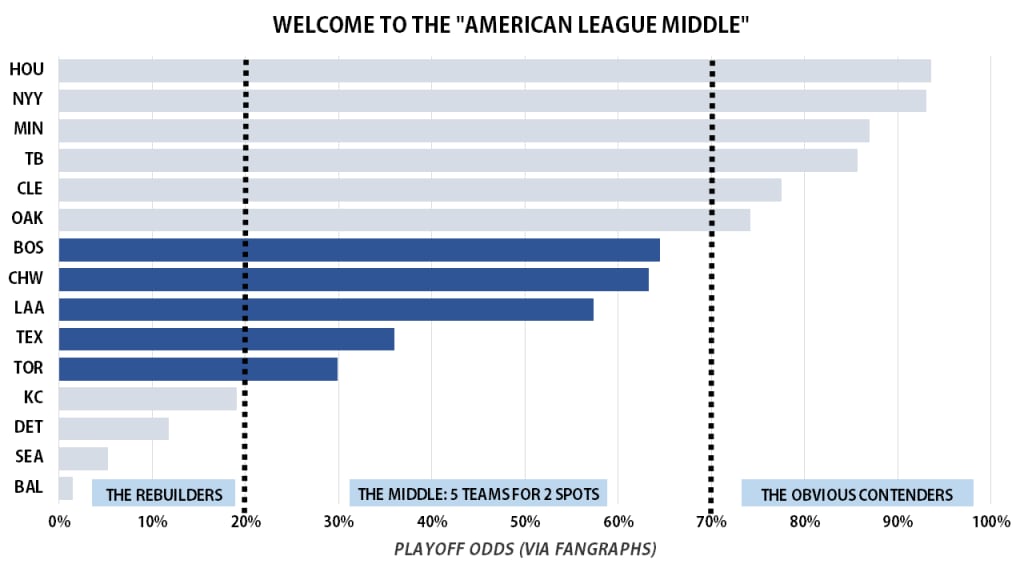
From the start of the 20th century through 1968, there were no divisions, just two leagues, each delivering its regular-season champion directly to the World Series. From '69 through '93, we had the East and the West in each league. In '94, the Central joined up. While we've since expanded from one Wild Card team to two, we've had the three-divisions-per-league setup for nearly three decades now.
Until 2020, anyway, because in the American League, at least, there's an unofficial fourth division.
Let's call it the "AL Middle," and it's an unexpected side effect of the move from 10 playoff teams to 16. Because of how stratified the league is -- a few great teams, a few very weak teams -- there's now a group of several clubs in the middle who are now truly competing against one another, instead of the other clubs in their division. (This doesn't really apply in the NL so much, which has just one great team, the Dodgers, and a wide-open field otherwise.)
As a reminder, since this is all so new, here's how the new format works. It's eight teams, sure, but it's not simply "the eight teams with the best record." Instead, it breaks down into three groups.
• Teams 1-3 -- the three division winners, ordered by record
• Teams 4-6 -- the three second-place teams, ordered by record
• Teams 7-8 -- the two best remaining records
Now, if you were to go look at the FanGraphs playoffs odds, they -- for the most part -- align with the eye test. There are six teams with playoff odds of at least 70% or better: Astros, Yankees, Twins, Rays, Indians and A's. No controversy there, right? Cream of the crop. On the other hand, there are four teams with playoff odds of 20% or worse: Royals, Tigers, Mariners and Orioles. All rebuilders, so no surprises there.

So, let's take those projections, and plug those into the format above.
• Teams 1-3 -- Yankees, Astros, Twins
• Teams 4-6 -- Rays, Indians, A's
• Teams 7-8 -- the two best remaining records
Those final two teams, Nos. 7 and 8, can come from any division. They're going to be the best records from teams that finish third or worse, which means we're left with five teams fighting one another for two spots.
Welcome to the "AL Middle"
Adjusted playoff odds entering season vs. previous 60-game format
Red Sox (65% / 34%)
White Sox (64% / 33%)
Angels (57% / 27%)
Rangers (36% / 14%)
Blue Jays (30% / 10%)
We'll accept some quibbles with those numbers, though arguing with the computers is somewhat futile. (Personally, we like the exciting young talent of the Blue Jays over the thin pitching of the Red Sox, while at the same time accepting that Rafael Devers, J.D. Martinez and Xander Bogaerts are all true superstars.)
You get the main points, though. First, this is the middle group, the ones with more realistic hopes of success than the four teams at the bottom, yet not quite as high hopes as the six teams at the top. Second, each and every one of these clubs just saw its playoff odds shoot up by two to three times.
For example, the Red Sox and Blue Jays aren't competing with the Yankees and Rays, two teams they have little chance of catching. The Rangers and Angels aren't going to outplay the Astros and A's; they just need to beat out the pair of Sox and the Blue Jays. (The improved White Sox probably do have their sights set on the top of the AL Central, but we're being realistic after seven consecutive losing seasons.)
Which means: Five teams. Two spots. With the prize, we guess, of being the road team against the Yankees and either the Astros or Twins -- or whichever clubs get the top two seeds, but isn't that better than not playing at all? It feels like it is.
So that's your new division, the "AL Middle," notable in one way because they don't actually all play one another. The Rangers and Angels will face each other 10 times, but not the other three. The Blue Jays and Red Sox will play each other 10 times, presumably some of which will come in Buffalo, but not at all against the other three clubs. The White Sox won't face their new "division" mates at all.
If we were to look at opposing strength of schedule for our new division, it looks like this. Small margins, to be sure, but a bonus for the White Sox, who get 24 games -- that's 40% of their schedule -- against the Royals, Tigers and Pirates.
Rangers (.505)
Angels (.504)
Blue Jays (.500)
Red Sox (.494)
White Sox (.485)
"Divisional play," as it were, gets going on Aug. 7, when the Angels visit the Rangers, while the Red Sox host the Blue Jays. You'll still see the traditional standings, split into East, Central and West, and it's certainly possible -- perhaps very possible -- that one of these teams will outplay expectations and find itself holding one of the top two spots in its actual division at the end of the season. In a year like this, absolutely nothing should surprise you. But based on where we sit right now, the Blue Jays don't have to worry about the Rays and Yankees; the Angels and Rangers need not worry about the Astros.
This is the new division. This is the race to watch. It's not official, but it's real.
